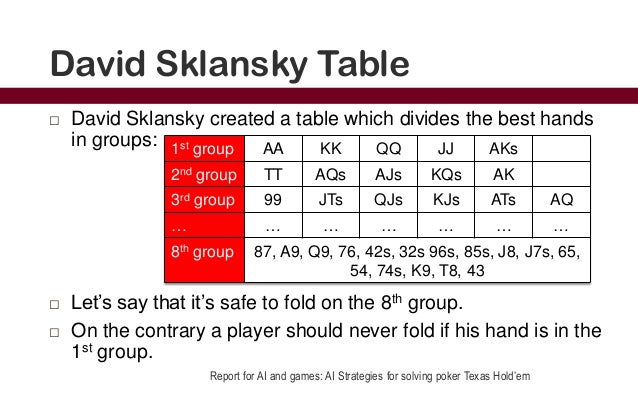Sklansky’s Group 4 has been significantly changed by the Carnegie Mellon group, and I agree with those changes. However, I disagree with the order of the hands within the group. Sklansky’s Hand Rankings. When writer and 'poker professor' David Sklansky in 1976 published his book, 'Hold'em Poker', he introduced a revolutionary system for starting hand selection in Texas Hold'em. This system has since then been considered The Holy Grail of Poker. Sklansky's 'Hand Ranking Groups', which he later explored in greater detail in the book, 'Hold'em Poker for Advanced Players' (co-written. One of the salient facts about this book is that Sklansky discusses poker strategy in the context of many variations, such as razz, stud, and draw poker. One the one hand, this approach allows the reader to see how there are many general principles of poker that hold regardless of the particular rules. The Theory of Poker by David Sklansky discusses theories and concepts applicable to nearly every variation of the game, including five-card draw (high), seven-card stud, hold 'em, lowball draw, and razz (seven-card lowball stud).
Based on the tabulated data and chart generated, there are a few interesting observations to be made. The are listed below:

1. Pair A is best hand
There should be no surprise that Pair A is the best hand. Having a pair A, helps you to easily get the best possible double pair combo or three-of-kind combo. While it might be harder to strike straight or flush with it, those scenarios are typically less likely to happen. Thus, making pair A better in general.
Sklansky Poker Hand Rankings
2. Offsuit 72 is the worst hand
This might be less known to people and it could be counter intuitive. Some might have thought that perhaps Offsuit J2 would be worse than Offsuit 72. But, that is not the case.
To understand why this is the case, we can start thinking about what are combinations that are most likely to lead to a winning combo assuming no one folds. Given any hands, we are more likely to win with double pair, followed by 3-of-a-kind, straight flush and so forth.

With offsuit 72, we are more likely to win double pair of pair 7 and pair 2, followed by three-of-a-kind and so on. However, it is also worthwhile to note that it is highly like other players has a better double pair or three-of-a-kind. This bring us to the next important lesson to learn.
3. Having a suited, closely connected hand with A, K or Q is better than having pairs that is less than 9
If you were to investigate the table or chart, the hand ranked 5th is Suited AK. What is even more interesting is pairs hand only took 6 spots from rank 1 to rank 20. Most of the remaining spots were taken up by suited, closely connected hands with a high card like A, K or Q.
The reason for this is similar to previous point that we made. It is more frequent that players will win using double pairs or 3-of-a-kind. Therefore, having a higher card helps to push you to a better standing to win.
One final note on this topic - Pair 9 is the last pair hand ranked in the top 20 hands. Playing any other pairs hand may not be as good as conventional wisdom might suggest.
Sklansky Poker Starting Hands
4. Winning chance drops fast within the top 7 ranked hands
Sklansky Poker Hands
This is the lesson that really took us by surprised. While developing our poker odds calculator, we did had a sense that odds of winning was somewhat asymmetric. But, the chart above really solidify how much the asymmetry was.
Within the top 7 ranked hands, the probability of winning drops really fast from paired A to paired K and so forth. If you get the top 7 hands, you really should work hard to get through the preflop.
5. You are more likely to win a 6 players match than a 9 players one
A player with hands that are in the top 7 ranks in a 6 players game have a much better chance of winning in a 9 players game. For example, Paired A has roughly 49.5% preflop winning probability in a 6-player game compared to only 35% in a 9-players game. While 14.5% difference is not as big as it sounds, it has a significant impact on the pot odds that you will need to make a value play. In short, it might be easier to make money off a 6 players game rather than a 9 players game.
6. In a no-folding six players match, your hand range to play is very large
Sklansky Poker Hands
This point is not as crucial as other points we have made. But, we find this observation quite interesting although it is unlikely to happen in real life.

Suppose that we are in a no-folding 6 players Texas Hold'Em match. During every betting session, our pot odds is 5-to-1. This means that for every $1 we bet, we stand to win $5.
Based on this pot odds, our break-even pot equity or winning odds is around 16.67%. Using the chart above, we can see that we can play any hands better than rank 106. This means that players can play 105 types of hands out of 169 types (59.2% of all types) and still perform better than break even! Basically, you have a very large hand range to play in this type of situation.
Nonetheless, this is a just-for-fun analysis, which does not happen that often in real life. Based on some of our experience playing, it could happen sometimes during preflop though.
7. Our hand rankings are similar to Sklansky hand groups

Sklansky hand groups was formulated by David Sklansky and Mason Malmuth. Both of these old school poker players understand the math very well. It is no surprise that our hand rankings aligns very well with their proposed hand groups.
Sklansky hand group proposes that Tier 1 group consists of pair A, pair K, pair Q, pair J and suited AK. These cards are essentially ranked 1 to 5 via our Monte Carlo simulation. The same observation can be made for Sklansky Tier 2 and Tier 3 hand group.